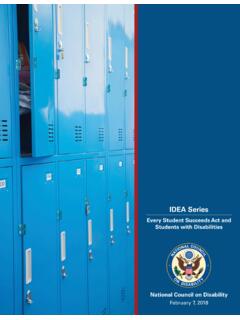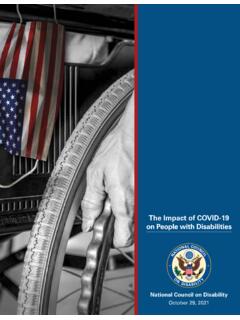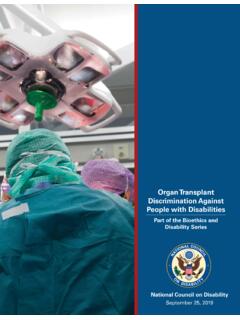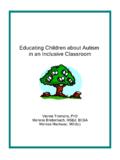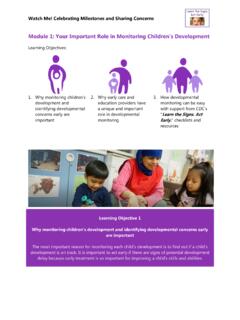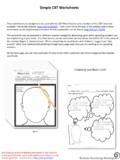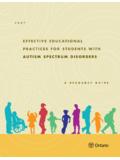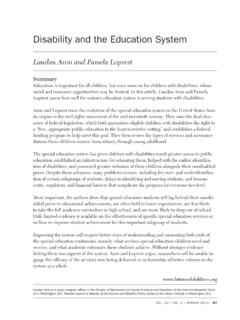Transcription of IDEA Series: The Segregation of Students with Disabilities
1 National Council on DisabilityFebruary 7, 2018 IDEA Series The Segregation of Students with DisabilitiesNational Council on Disability (NCD)1331 F Street NW, Suite 850 Washington, DC 20004(IDEA Series) The Segregation of Students with DisabilitiesNational Council on Disability, February 7, 2018 Celebrating 30 years as an independent federal agencyThis report is also available in alternative formats. Please visit the National Council on Disability (NCD) website ( ) or contact NCD to request an alternative format using the following Email202-272-2004 Voice202-272-2022 FaxThe views contained in this report do not necessarily represent those of the Administration, as this and all NCD documents are not subject to the A-19 Executive Branch review of TransmittalFebruary 7, 2018 President Donald J. TrumpThe White House1600 Pennsylvania Avenue NWWashington, DC 20500 Dear Mr.
2 President:On behalf of the National Council on Disability (NCD), I am pleased to submit this report titled The Segregation of Students with Disabilities . This report is part of a five-report series on the Individuals with Disabilities Education Act (IDEA) that describes the legal and scientific basis for an inclusive versus segregated education, summarizes national patterns for educating Students with Disabilities in general education classes, examines federal and state guidance, and state compliance with federal mandates, describes effective educational practices for reducing Segregation , and provides findings and recommendations for you know, the right of Students with Disabilities to receive a free and appropriate public education in the least restrictive environment is solidly rooted in the guarantee of equal protection under the law granted to all citizens under the Constitution.
3 In enacting IDEA, Congress sought to end the long history of Segregation and exclusion of children with Disabilities from the American public school system. IDEA requires that Students with Disabilities be educated to the maximum extent possible with Students without Disabilities . However, many Students with Disabilities remain segregated in self-contained classrooms or in separate schools, with limited or no opportunities to participate academically and socially in general education classrooms and school activities. Many do not have access to the same academic and extracurricular activities and services provided to other Students . Frequently, these Students leave school unprepared for adult life in the stands ready to assist the Administration in ensuring the right to a free and appropriate public education for Students with Disabilities as set forth in ,Clyde E.
4 TerryChairpersonNational Council on DisabilityAn independent federal agency making recommendations to the President and Congress to enhance the quality of life for all Americans with Disabilities and their F Street, NW Suite 850 Washington, DC 20004202-272-2004 Voice 202-272-2074 TTY 202-272-2022 Fax (The same letter of transmittal was sent to the President Pro Tempore of the Senate and the Speaker of the House of Representatives.)2 National Council on DisabilityNational Council on Disability Members and StaffMembersClyde E. Terry, ChairpersonBenro T. Ogunyipe, Vice ChairpersonBilly W. AltomRabia BeltJames T. BrettBob BrownDaniel M. GadeWendy S. HarbourNeil RomanoStaffVacant, Executive DirectorJoan M. Durocher, General Counsel & Director of PolicyAmy Nicholas, Attorney AdvisorAmged Soliman, Attorney AdvisorAna Torres-Davis, Attorney AdvisorAnne Sommers, Director of Legislative Affairs & OutreachPhoebe Ball, Legislative Affairs SpecialistLisa Grubb, Director of Operations and AdministrationStacey S.
5 Brown, Staff AssistantKeith Woods, Financial Management AnalystThe Segregation of Students with Disabilities 34 National Council on DisabilityAcknowledgmentsThe National Council on Disability thanks Selene Almazan, Denise Marshall, and Melina Latona of the Council of Parent Attorneys and Advocates; and Carol Quirk of the Maryland Coalition for Inclusive Education, for the research conducted in developing this Segregation of Students with Disabilities 56 National Council on DisabilityContentsAcknowledgments ..5 Contents ..7 Executive Summary ..9 Key Findings ..9 Key Recommendations ..9 Acronym Glossary ..11 Introduction ..13 Research Methods ..14 Qualitative Analysis ..14 Policy Analysis and Literature Review ..15 Literature, Case Law, and Legislative Review ..15 Quantitative Data ..16 National Data Review.
6 16 Limitations ..16 Chapter 1: Legal Foundation for Inclusion ..17 Early Litigation and Legislation ..17 The Right to a Public Education ..17 Individuals with Disabilities Education Act ..18 The LRE Requirement ..18 Placement Decisions ..18 Case Law ..19 Chapter 2: National Placement Data ..23 Placement Practices across States ..23 Disproportionate Placement Practices across Disability Labels ..24 Disproportionate Placement across Racial/Ethnic Groups ..25 Chapter 3: Federal and State Response ..27 Federal Policy Letters and Guidance ..27 State Regulations and Guidance ..28 Monitoring and Technical Assistance ..32 The Segregation of Students with Disabilities 7 Chapter 4: Challenges to Inclusive General Education Placement ..33 Continuum of Placements ..33 Attitudes and Beliefs ..34 Organizational Traditions.
7 35 Organizational and Workforce Capacity ..35 Chapter 5: The Research Base: Why Include Students with Disabilities ..37 Benefits to Students with Disabilities ..37 Benefits to Students without Disabilities ..39 Opportunity to Learn: Special Versus Regular Classes ..39 Chapter 6: The Research Base: Strategies That Promote Effective Inclusive Education ..41 Universal Design for Learning ..41 Cooperative Learning ..41 Differentiated Instruction ..42 Data-Based Instructional Decisions ..42 Positive Behavior Interventions and Supports ..42 Peer-Assisted Learning ..43 Culturally Responsive Teaching ..43 Multi-Tiered System of Supports ..44 Chapter 7: Findings and Recommendations ..45 Findings ..45 Policies ..45 Effectiveness ..45 Demographics ..45 Disability ..45 Race ..45ED Response ..45 Recommendations.
8 46 APPENDIX ..49 National and State Placement Practices ..49 Endnotes ..538 National Council on DisabilityThe legal and scientific basis for special education services points to the positive outcomes for Students with Disabilities when they receive an inclusive versus segregated education. Yet nationally, Students with Disabilities , in particular Students of color and Students in urban settings, as well as Students with specific disability labels (such as autism or intellectual disability), continue to be removed from general education, instructional, and social opportunities and to be segregated disproportionately when compared to White Students who live in suburban and rural areas and those who have less intensive academic support FindingsFor this report, national student placement patterns, as well as federal and state policies, were reviewed to understand the state of special education service delivery and administrative guidance.
9 This was supplemented by a review of research and input from families and educators about their experiences in educating Students with Disabilities . We found that, although states are required to first consider that a student with a disability should attend the school that they would attend if they did not have a disability and only if the student s needs cannot be met, this consideration was not always present. States are expected to only remove the student to the extent needed to implement the student s individual plan and meet individually designed goals. Further, research demonstrates that inclusive education results in the best learning outcomes; there is no research that supports the value of a segregated special education class and school. The emerging picture, however, is one in which the opportunity for Students to participate in their neighborhood school alongside their peers without Disabilities is influenced more by the zip code in which they live, their race, and disability label, than by meeting the federal law defining how student placements should be made.
10 While there are states and examples of schools that are indeed meeting the learning needs of Students even those with extensive support needs that is more the exception than the rule. While the Federal Government monitors and reviews state performance on a number of indicators, including placement practices, there does not appear to be sanctions or strong guidance that directs states to attend to this RecommendationsIt is recommended that Congress support full funding for special education, and that any funding authorized by Congress emphasize the delivery of special education services in general Executive SummaryThe Segregation of Students with Disabilities 9education settings. Further, discretionary grants for research and development should establish expectations for inclusive school practices, particularly those that address personnel development and organizational changes to sustain effective education services that address the needs of all Students in an equitable manner to achieve equitable outcomes.

